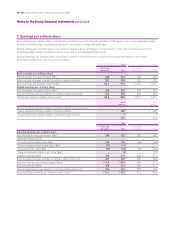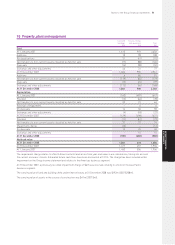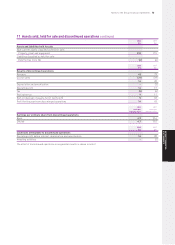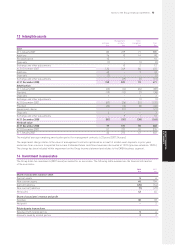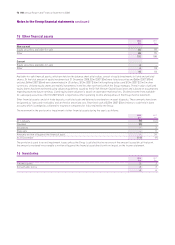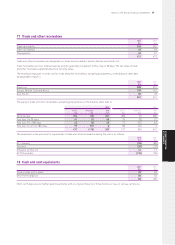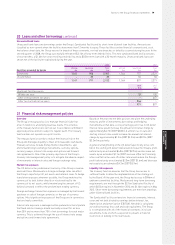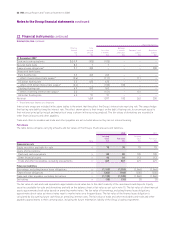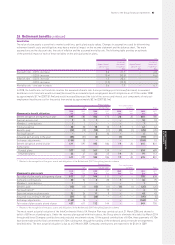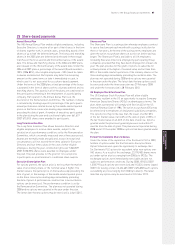Holiday Inn 2008 Annual Report Download - page 81
Download and view the complete annual report
Please find page 81 of the 2008 Holiday Inn annual report below. You can navigate through the pages in the report by either clicking on the pages listed below, or by using the keyword search tool below to find specific information within the annual report.
Notes to the Group financial statements 79
20 Loans and other borrowings continued
Unsecured bank loans
Unsecured bank loans are borrowings under the Group’s Syndicated Facility and its short-term bilateral loan facilities. Amounts are
classified as non-current when the facilities have more than 12 months to expiry. These facilities contain financial covenants and, as at
the balance sheet date, the Group was not in breach of these covenants, nor had any breaches or defaults occurred during the year. In the
second quarter of 2008, the Group successfully refinanced $2.1bn of long-term debt facilities. This new syndicated bank facility consists
of two tranches; a $1.6bn five-year revolving credit facility and a $0.5bn term loan with a 30-month maturity. Unsecured bank loans are
shown net of the facility fee capitalised during the year.
2008 2007
Utilised Unutilised Total Utilised Unutilised Total
Facilities provided by banks $m $m $m $m $m $m
Committed 1,161 946 2,107 1,564 757 2,321
Uncommitted –2525 –5050
1,161 971 2,132 1,564 807 2,371
2008 2007
$m $m
Unutilised facilities expire:
Within one year 25 150
After one but before two years –657
After two but before five years 946 –
971 807
21 Financial risk management policies
Overview
The Group’s treasury policy is to manage financial risks that
arise in relation to underlying business needs. The activities
of the treasury function are carried out in accordance with Board
approved policies and are subject to regular audit. The treasury
function does not operate as a profit centre.
The treasury function seeks to reduce the financial risk of the
Group and manages liquidity to meet all foreseeable cash needs.
Treasury activities include money market investments, spot
and forward foreign exchange instruments, currency options,
currency swaps, interest rate swaps and options and forward
rate agreements. One of the primary objectives of the Group’s
treasury risk management policy is to mitigate the adverse impact
of movements in interest rates and foreign exchange rates.
Market risk exposure
The US dollar is the predominant currency of the Group’s revenue
and cash flows. Movements in foreign exchange rates can affect
the Group’s reported profit, net assets and interest cover. To hedge
translation exposure, wherever possible, the Group matches the
currency of its debt (either directly or via derivatives) to the
currency of its net assets, whilst maximising the amount of US
dollars borrowed to reflect the predominant trading currency.
Foreign exchange transaction exposure is managed by the forward
purchase or sale of foreign currencies or the use of currency
options. Most significant exposures of the Group are in currencies
that are freely convertible.
Interest rate exposure is managed within parameters that stipulate
that fixed rate borrowings should normally account for no less
than 25% and no more than 75% of net borrowings for each major
currency. This is achieved through the use of interest rate swaps
and options and forward rate agreements.
Based on the year end net debt position and given the underlying
maturity profile of investments, borrowings and hedging
instruments at that date, a one percentage point rise in US dollar
interest rates would increase the annual net interest charge by
approximately $4.7m (2007 $5.8m). A similar rise in euro and
sterling interest rates would increase the annual net interest
charge by approximately $1.2m (2007 $1.2m) and $0.9m (2007
$3.2m) respectively.
A general strengthening of the US dollar (specifically a five cent
fall in the sterling:US dollar rate) would increase the Group’s profit
before tax by an estimated $4.0m (2007 $2.9m) and decrease net
assets by an estimated $1.1m (2007 increase of $6.1m). Similarly,
a five cent fall in the euro:US dollar rate would reduce the Group’s
profit before tax by an estimated $2.0m (2007 $1.6m) and decrease
net assets by an estimated $4.3m (2007 $5.9m).
Liquidity risk exposure
The treasury function ensures that the Group has access to
sufficient funds to allow the implementation of the strategy set
by the Board. At the year end, the Group had access to $946m of
undrawn committed facilities. Medium and long-term borrowing
requirements are met through the $2.1bn Syndicated Facility of
which $0.5bn expires in November 2010 and $1.6bn expires in May
2013. Short-term borrowing requirements are met from drawings
under bilateral bank facilities.
The Syndicated Facility contains two financial covenants; interest
cover and net debt divided by earnings before interest, tax,
depreciation and amortisation (EBITDA). Net debt is calculated
as total borrowings less cash and cash equivalents. The Group
is in compliance with all of the financial covenants in its loan
documents, none of which is expected to present a material
restriction on funding in the near future.
GROUP FINANCIAL
STATEMENTS



